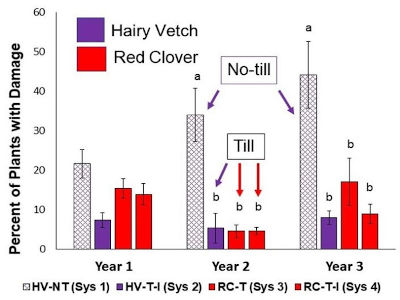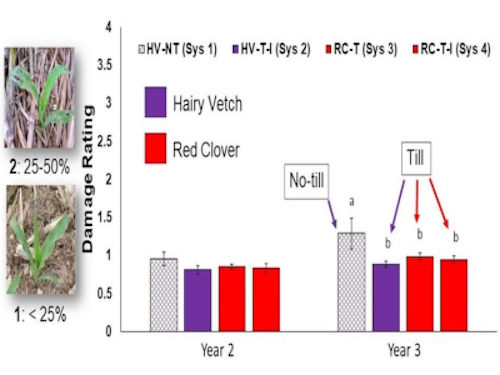By Mary Barbercheck and Karly Regan
Organic cover crop management does not promote insect damage in tilled and no-til corn systems.
The growing demand for organic livestock, poultry, and eggs is driving Pennsylvania’s #3 ranking for organic sales in the U.S., following #1 ranked California and #2 Washington. The demand for organic feed and forages to support these organic production sectors currently outstrips the domestically-produced supply, with the result that much of organic feed grains are imported. The shortage of U.S.-produced organic feed grains represents an opportunity for U.S. corn and soybean growers, as there is a considerable price premium offered for organic compared with conventionally-produced feed grains.
In organic production, the use of synthetic insecticides and fertilizers, and transgenic varieties are prohibited, and growers must rely mainly on biological control, tillage, crop rotation, and other cultural practices to manage pests. Some conventional growers are hesitant to transition to organic production due to concerns about yield losses to insect pests. Former entomology graduate student Karly Regan measured damage to organic corn from multiple invertebrate pests, including slugs, black cutworm, true armyworm, European corn borer, corn earworm, and fall armyworm, early and late in the growing season in four organic cropping systems that varied in tillage frequency and intensity and in winter cover crop species. Specific management practices examined in the Reduced-tillage Organic Systems Experiment (ROSE) at Penn State’s Russell E. Larson Agricultural Research Center included two cover crop mixtures preceding corn (hairy vetch/triticale vs red clover/timothy) and their termination method, as well as the timing and method of establishing the winter cover crop. The four treatments compared were:
- System 1: HV-NT (Sys 1) corn no-till planted into hairy vetch/triticale terminated with a roller-crimper;
- System 2: HV-T-I (Sys 2) = corn following termination of red clover/timothy using mowing and incorporation with a moldboard plow, corn inter-seeded with cover crops at V6;
- System 3: RC-T (Sys 3) = corn following termination of red clover/timothy using mowing and incorporation with a moldboard plow;
- System 4: RC-T-I (Sys 4) = corn following termination of red clover/timothy using mowing and incorporation with a moldboard plow, corn inter-seeded with cover crops at V6.
In the no-till treatment, cover crops were terminated with a roller-crimper and weed management was accomplished with a shallow high-residue cultivator that left the cover crop residue largely undisturbed. In the tilled treatments, the cover crops were terminated by mowing and incorporation with a moldboard plow before planting corn, and weeds were managed with flex-tine weeding, rotary hoeing, and inter-row cultivation as needed after termination of the cover crop mixtures. In systems with cover crop inter-seeding, a mixture of annual ryegrass, orchardgrass, and forage radish was drilled between the rows of V6 corn. Inter-seeding cover crops into a standing corn crop is a way to establish winter cover crops where a short-growing season may not usually allow fall seeding after corn harvest.
We measured the number of V2 corn plants with insect damage (prevalence) and rated the intensity of damage to each plant based on a scale of 1 (little to no damage) to 4 (severe damage). Early season insect damage can be an important yield-limiting factor in corn if the damage reduces plant population. Prevalence of early-season damage ranged from about 3% to nearly 50% (Graph 1) of plants showing damage; however, the severity of damage to each plant was very low, even where prevalence of damage was high, and damage was unrelated to corn yield (Graph 2). Slug feeding was consistently the most common type of early-season damage to corn. The proportion of corn plants affected by chewing insect pests and slugs early in the season was lower in treatments where the cover crops were terminated with tillage compared to termination with a roller crimper. Neither cover crop nor tillage treatment affected the numbers of or damage from late-season caterpillar pests (fall armyworm, European corn borer, and corn earworm) or corn yield. Predation by natural enemies appear to have effectively maintained damage from chewing pests below yield-damaging levels. These results support the inclusion of winter and inter-seeded cover crops in organic crop rotations to gain environmental benefits without increasing risks of yield-limiting damage by insect pests.
Graph 1. Percentage of V2 corn plants with insect damage (prevalence) in 4 organic cropping systems. HV-NT (Sys 1) = corn no-till planted into hairy vetch/triticale terminated with a roller-crimper; HV-T-I (Sys 2) = corn following termination of red clover/timothy using mowing and incorporation with a moldboard plow, corn inter-seeded with cover crops at V6; RC-T (Sys 3) = corn following termination of red clover/timothy using mowing and incorporation with a moldboard plow; RC-T-I (Sys 4) = corn following termination of red clover/timothy using mowing and incorporation with a moldboard plow, corn inter-seeded with cover crops at V6. Bars with the same letters are not significantly different from each other.

Graph 2. Severity of insect damage to V2 corn in 4 organic cropping systems. Damage ratings: 1 = < 25% of plant damaged; 2 = 25-50% of plant damage. HV-NT (Sys 1) = corn no-till planted into hairy vetch/triticale terminated with a roller-crimper; HV-T-I (Sys 2) = corn following termination of red clover/timothy using mowing and incorporation with a moldboard plow, corn inter-seeded with cover crops at V6; RC-T (Sys 3) = corn following termination of red clover/timothy using mowing and incorporation with a moldboard plow; RC-T-I (Sys 4) = corn following termination of red clover/timothy using mowing and incorporation with a moldboard plow, corn inter-seeded with cover crops at V6. Bars with the same letters are not significantly different from each other.
Source : psu.edu